Abstract
Polycrystalline diamond (PCD)-coated mechanical seal rings were prepared by hot filament chemical vapor deposition (HFCVD) on graphite-loaded silicon carbide (GSiC) substrates. From the initial deposition process, the diamond first nucleated and then grew into a dense coating with grain size of 4 μm and thickness of 12.3 μm. The well-grown PCD coating, as confirmed by Raman spectroscopy and X-ray diffractometry, significantly improves the pressure–velocity limit of the mechanical seal applied in harsh operating conditions, no matter whether for a hard-to-soft mating combination or a hard-to-hard mating combination. Comparing GSiC against sintered silicon carbide (SSiC) combination (GSiC/SSiC), GSiC against graphite combination (GSiC/graphite) and PCD against graphite combination (PCD/graphite), PCD against SSiC combination (PCD/SSiC) shows the highest pressure velocity (PV) limit of 42.31 MPa·m/s with 4 kN loading at 4500 rpm rotation speed. An extremely low and stable friction coefficient and super mechanical properties under harsh conditions can be approved as the source of the high PV limit of PCD coating. A mechanical seal with PCD coating can be used for more demanding applications.
1. Introduction
Mechanical seals, which are readily available for sealing liquid and gaseous media, minimize liquid or gas leakage between the rotating shaft and stationary housing by maintaining a very small axial gap [1,2]. In these devices, the opposing faces of two annular rings, which form a rotating-stationary combination, contact together to obtain a sealing action. Because of their special structure and unique functions, mechanical seals, as a critical part of centrifuges, reactors, pumps, mixers, compressors and other similar devices, are used in a wide range of industrial applications, such as the metallurgy, mechanical, petrochemical, pharmacy, automobile, aerospace and nuclear industries. In practical applications, mechanical seals have to meet high demands regarding working pressure, rotation speed, chemical resistance, thermal resistance and extremely harsh operating environments. Especially, in heavy duty industrial applications, for example boiler feedwater, reactor cooling, oil and gas well drilling, mechanical seals require service at high speeds under elevated pressures [1].
For the reliability, longevity, emission control and safety of mechanical seals, and in order to meet increasingly harsh service requirements, the performance of the paired dynamic and stationary annular rings of mechanical seals plays a major role. Meanwhile, the performance of the mechanical seal is critically dependent on the seal face materials. Many different materials and combinations of mechanical seal have been successfully tested and are routinely used in the industry today [3,4]. Among all the comparing seal materials, sintered silicon carbide (SSiC) is commonly used due to its abrasion resistance, corrosion resistance, high hardness and thermal shock resistance. In order to offer the low frictional benefits of graphite within the mechanical strength of silicon carbide, graphite-loaded silicon carbide (GSiC) was designed and used [3]. Normally, the hard-to-soft face comparing seals, such as GSiC against graphite, is used due to their low cost and favorable self-lubricating properties. In particular, the hard-to-hard face comparing seals, such as GSiC against SSiC, are used in certain circumstances, such as high-viscosity fluid, sealing media with abrasive particles, loading or processes exceeding the mechanical properties of graphite. However, the useful lifetimes and serviceability limits of the mechanical seal are still limited by the failures due to unacceptable deformations and abrasive wear caused by severe or uneven loading, blistering, deficiencies, dry or near-dry running (especially at the startup) [5]. Therefore, an upper limit on the severity of the mechanical seal application is imposed by the material properties [6]. It is important to find the most appropriate materials to maximize the operating lives of these components, especially with sealing fluids under harsh operating conditions. In the case of crude oil applications, which is typical for high pressures, high speed and abrasive particle conditions, their mechanical seals required extremely hard and strong face materials.
Diamond is well-known for its unmatched hardness and offers low friction, high wear protection, and excellent chemical and thermal resistance. Thus, a mechanical seal face designed in combination with a polycrystalline diamond (PCD) coating could offer an outstanding abrasion resistance and, at the same time, a considerably improved performance under poor lubrication conditions like in high-viscosity fluids and even in dry-running condition due to the low friction coefficient. Numerous studies have confirmed that the diamond coatings considerably lower the friction and enhance the tribological performance in mechanical face seals [2,4,5,6,7,8,9,10,11,12,13,14]. However, there are few researches on the upper limit of mechanical seals with PCD coating application under conditions where the combination of high pressure and high surface speeds create high levels of pressure–velocity (PV). The PV limit, where P is the pressure drop across the seal and V is the mean sliding velocity [15], is a well-known parameter in designing mechanical seals, defining the operating envelope, and used as the most common approach to seal evaluation. Meanwhile, the comparison between the PV limits of diamond coating and uncoating mechanical seals has not been given much attention.
In this study, the PCD-coated mechanical seal ring was prepared by hot filament chemical vapor deposition (HFCVD) on GSiC substrates. The evolution of phase and morphologies on the substrate surface during the diamond growth process was investigated. In order to evaluate the performance of a mechanical seal with PCD coating, the PV limits of various mechanical seal material combinations with diamond coating and uncoating, hard-to-soft comparing and hard-to-hard comparing, including PCD against SSiC combination (PCD/SSiC), PCD against graphite combination (PCD/graphite), GSiC against SSiC combination (GSiC/SSiC) and GSiC against graphite combination (GSiC/graphite) were tested on the same friction and wear-testing machine with adjustable rotation speed and load. Meanwhile, the wear mechanism of the PCD combination was primarily explored. PCD coating could improve the substantially of the PV limit of mechanical seal for more demanding applications and the PV limit in this study can provide an important guide to material performance.
2. Materials and Methods
Hot filament chemical vapor deposition (HFCVD) was used to perform the diamond deposition due to its versatility, simplicity, and low cost of implementation, maintenance, and operation, while providing better control of the growth parameters [16].
The commercially available graphite-loaded silicon carbide seal rings (GSiC, Ningbo FLK Technology Co., Ltd., Ningbo, China) with 57 mm external diameter and 43 mm inner diameter sealing face were selected as a substrate for diamond deposition. Before depositing, the surface of the GSiC seal ring was ground uniformly with diamond grinding paste (particle size is about 0.1 μm) for 10 min to improve the nucleation density. After cleaning the surface with acetone and methanol, the GSiC seal rings were transferred into a deposition chamber. Several tantalum filaments 0.35 mm in diameter and 250 mm in length were uniformly distributed above the GSiC substrate with a distance of 10 mm between filament and substance and heated to over 2000 °C during the whole deposition process. The surface temperature of GSiC substrate was kept at 850 °C, controlled by cooling water. A gas mixture ratio of H2:CH4 = 100:7 at around 25 Torr was adopted as nucleation ambient for 0.5 h. Then a PCD coating was grown for another 5.5 h with a gas mixture ratio of H2:CH4 = 100:6 at around 20 Torr. After deposition, the surfaces were polished to reduce surface roughness Ra to 0.05 µm for application and performance evaluation.
The evolution of phase and morphologies on the substrate surface during the diamond growth process was characterized and measured using a scanning electron microscope (SEM, Model EVO18, ZEISS, Jena, Germany), X-ray diffractometer (XRD, D8 Advance, BRUKER, Karlsruhe, Germany) and confocal microscope Raman spectrometer (inVia Reflex, RENISHAW, Gloucester, UK) with 532 nm laser excitation.
The PV limit evaluation of the mechanical seal was performed on the Tribometer designed as in Figure 1 with loading and rotary devices. The upper dynamic ring rotates against the stationary one surrounded by circulating water at room temperature. The load, friction torque and temperature rise of the seal faces were measured by load sensor, torque sensor and thermoscope respectively.
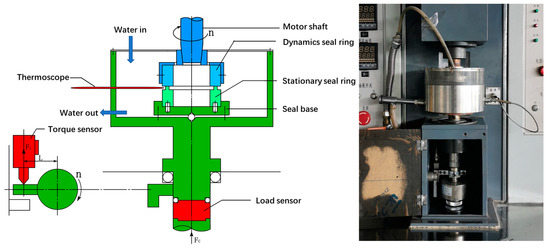
Figure 1.
Schematic and photograph of the PV evaluating experimental rig.
The evaluating procedure was that the seal was started up at 60 N load and accelerated to 1000 rpm. Then, the load was immediately increased to 0.2 kN. After establishing a basepoint condition, the seal was tested with load level and rotate speed increasing until the torque or temperature increased rapidly and the rotating suddenly paused with the rapid and complete failure of sealing. At this moment, the PV limits of each combination were recorded.
The PCD coatings were tested against SSiC, which was a typical hard material, and graphite, which was a typical soft material. For a comparison, the substrate GSiC against SSiC and graphite were tested under the same conditions. All the SSiC seal rings and graphite seal rings were commercially available and supplied by Ningbo FLK Technology Co., Ltd. Each test run provided information on PV performance. Each material combination provided a PV profile, including a PV limit above which stable conditions could not be sustained. In addition, information was obtained on friction coefficients and temperature variation.
After PV limit evaluation, the damaged scenes of different seal faces were observed by optical microscope (OM, DM2500 M, LEICA, Wetzlar, Germany).
3. Results and Discussion
3.1. Preparing of PCD Coating
The morphologies of the GSiC substrate surface before diamond deposition, diamond nucleation and growth were observed by the scanning electron microscope (SEM). According to the SEM images of the original substrate (Figure 2a), the scratches caused by grinding were detected. The depressions with the size of 1–2 μm, caused by the relatively soft graphite, which distributed in the silicon carbide ceramics, were clearly visible. After a 0.5 h nucleation process (Figure 2b), very tiny particles which were newly generated diamond seed crystals with the size of 50–300 nm were observed on the surface of the substrate, especially around the graphite depressions. During the deposition process, the tiny particles gradually spread over the substrate surface and continued to grow. After 4 h deposition (Figure 2c), it can be seen the PCD coating was continuous and very dense with the diamond grain size of 0.5–2 μm. Ultimately, the diamond grew to around 4 μm with different orientations after a 6 h deposition (Figure 2d). From the cross-sectional image of the PCD-coated seal ring (Figure 5c), it can be seen that the thickness of PCD coating was about 12.3 μm, and the diamond grown outwards in a randomized fashion.
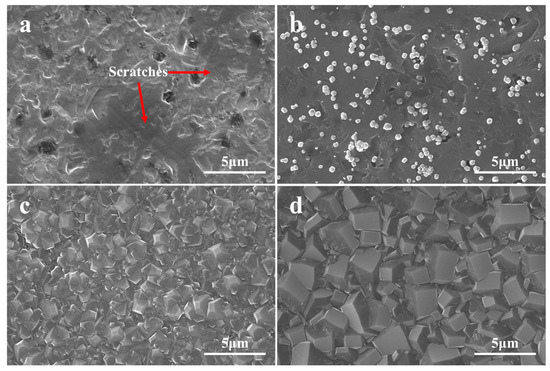
Figure 2.
Initial surface morphology of hot filament chemical vapor deposition (HFCVD) diamond coated graphite-loaded silicon carbide (GSiC) seals ring deposited for (a) 0 h (GSiC substrate), (b) 0.5 h (after nucleation), (c) 4 h and (d) 6 h.
The evolution of the seal ring face in the HFCVD process was simultaneously confirmed by the Raman spectrum and X-ray diffraction (XRD) results. According to the Raman spectrum results (Figure 3), two characteristic peaks of SiC at 785 and 965 cm−1 [17,18], and a low peak indicated graphite sp2 were detected on the GSiC substrate. In contrast, the Raman spectrum recorded from a complete PCD coating shows the characteristic diamond sp3 peak at 1335 cm−1, a broad amorphous carbon peak centered at 1520 cm−1 and a tiny nano-diamond peak at 1130 cm−1 [19,20,21,22,23]. It illustrates that there are fewer internal stresses and a few diamond-like or graphite regions in the coating. From the initial to final state, the intensity of SiC peaks decreased and the intensity of diamond peaks increased. The full width at half maximum (FWHM) of diamond sp3 peak in the final PCD coating was 5 cm−1 which was very small, meaning low crystalline defects and anisotropic stress distribution.
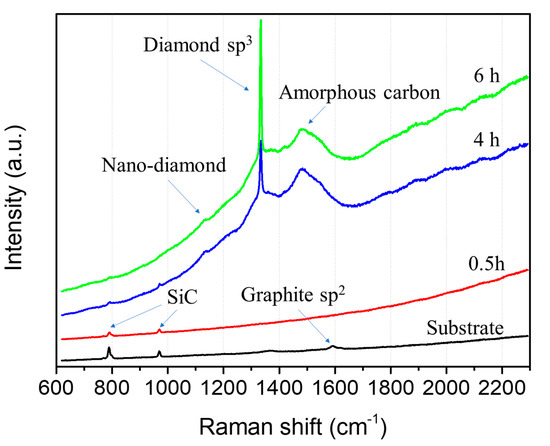
Figure 3.
Raman spectrum of the HFCVD diamond coated GSiC seals ring deposited for 0 h (GSiC substrate), 0.5 h (after nucleation), 4 h and 6 h.
X-ray diffraction results associated with the PCD coating at the critical growth points are shown in Figure 4. It can be seen the GSiC substrate is hexagonal. The presence of diamond (111) and (311) peaks confirmed that the PCD coatings were not textured. The XRD results show the good crystallinity of finial PCD coating, which ensures the unique performance of the diamond itself.
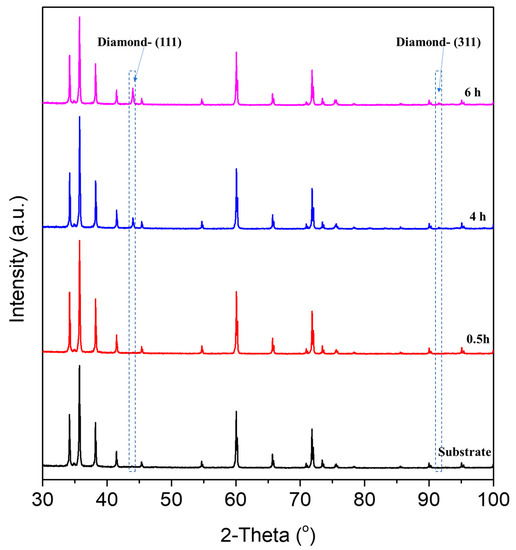
Figure 4.
X-ray diffraction (XRD) results of the HFCVD diamond coated GSiC seals ring deposited for 0 h (GSiC substrate), 0.5 h (after nucleation), 4 h and 6 h.
However, large grains of PCD coating with good crystallization may result in rough surfaces, which were not conducive to mechanical seal applications. According to Figure 5b, after polishing, the edges and comers of diamond particle in PCD coating were cut off and ground flush.
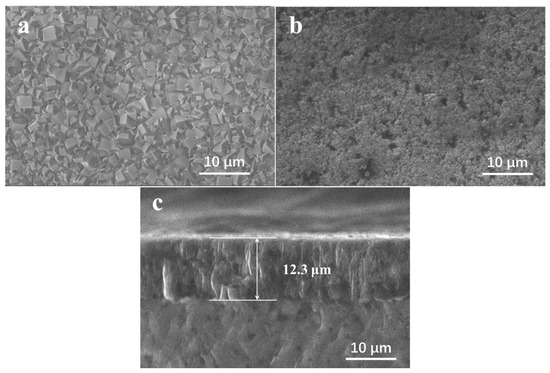
Figure 5.
The scanning electron microscope (SEM) images of (a) initial surface, (b) polished surface and (c) cross-sectional morphology of the polycrystalline diamond (PCD) coating.
3.2. Evaluation of PV Limit
The PV limit as a maximum serviceability parameter in the PCD/SSiC combination of a mechanical seal was tested on the Tribometer described above. Meanwhile, the evolution of PV values with applied load and rotational speed was recorded as shown in Figure 6. In the early stage, the PCD/SSiC combination was started up at 60 N load and accelerated to 1000 rpm. At this point, the load was immediately increased to 0.2 kN for a transient adaptive operation. As the load increased to 1 kN, full sealing was achieved for a PV product of approximately 2.32 MPa·m/s. In the subsequent stages, the applied load at the rate of 1 kN, and the rotational speed at the rate of 500 or 1000 rpm, increased alternately according to the running state of the Tribometer. Every change in rotational speed will result in an instant increase in the PV value, while the PV increases slowly with the load. Ultimately, the mechanical seal gets stuck suddenly during loading from 4 kN to 5 kN at 4500 rpm. The PV limit of prepared PCD/SSiC combination is 42.31 MPa·m/s.
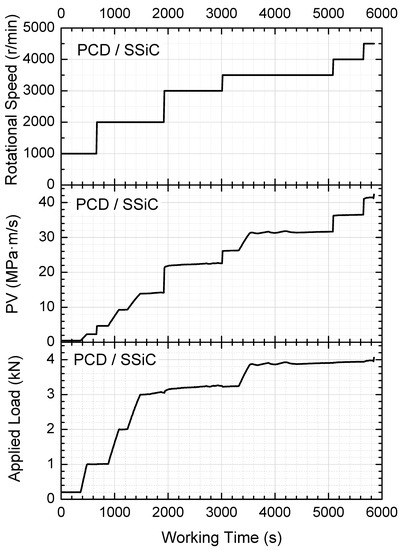
Figure 6.
Evolution of PV values with applied load and rotational speed of PCD/SSiC combination.
A similar process was used for the other three combinations. The comparison results showed that the PV limits of PCD/graphite combination, GSiC/SSiC combination and GSiC/graphite combination were 29.97, 23.61 and 20.75 MPa·m/s respectively as in Figure 7. It can be seen that the PV limit of mechanical seal rings is significantly improved comparing the uncoated ones with mating with the same material face.
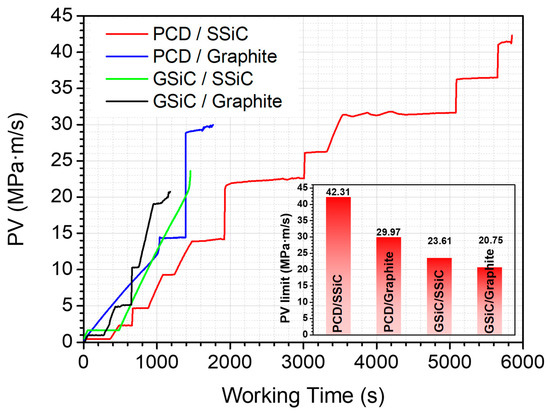
Figure 7.
Comparison of PV values and PV limit values of four mating combinations.
High load and high speed were responsible for excessive heat at the contact provoking the raising of the circulating water temperature. The relationship between the frictional heat generated ΔT (temperature rise) and the PV value of the four-seal face material combination is shown in Figure 8. The frictional heat ΔT is as a function of increasing PV for the combinations examined. The two hard-face combinations with SSiC produced less frictional heat, for a given load and PV, when compared to that produced by the other hard-to-soft face combinations with graphite. Graphite as a soft material and could not withstand strong shocks by a high load, resulting in micro-abrasion to accelerate wear and improve temperature. This shows the value that could be gained from the hard-to-hard face comparing seals for ultra-high load and VP value applications.
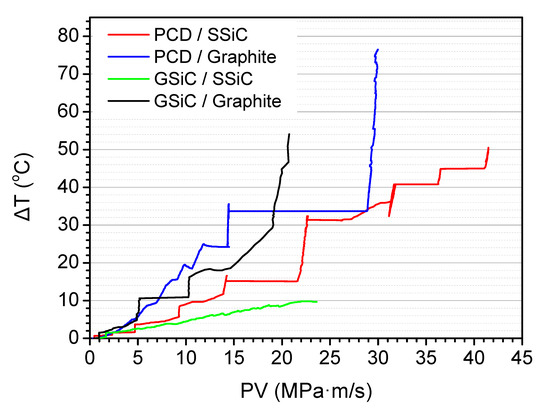
Figure 8.
The relationship between the frictional heat generated ΔT (temperature rise) and the PV value.
The friction curves corresponding to the variation of the PV value are given in Figure 9. In the initial stage, the friction coefficient of all combinations is higher than 0.2. After some fluctuation with self-polishing (micro-abrasion), resulting in a further accommodation of the contact mating surfaces, low friction values less than 0.04 were obtained. When the operating conditions become severe enough to improve the PV value above 5 MPa·m/s, the friction coefficient diminished very quickly. The trend for hard-to-hard face comparing seals was identified as that reducing the friction coefficient with increasing PV values, which can be seen for the PCD/SSiC combination and GSiC/SSiC combination. In contrast, for hard-to-soft face comparing seals, such as the PCD/graphite combination and GSiC/graphite combinations, the friction coefficient decreases in the initial stage with increasing PV value, then increases moderately in the later stage with increasing load. The reason may be that excessive loads accelerate the wear and tear of graphite because of the low strength of graphite. Broken debris falls into the gap between two seal faces leading to increasing friction. Meanwhile, resulting in the relatively low strength, the graphite seal ring is bound to be damaged early against a high load.
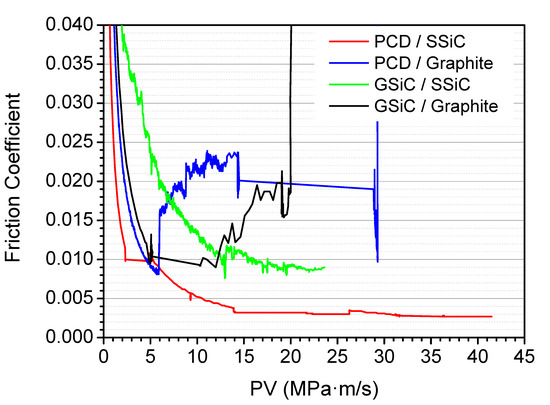
Figure 9.
The friction curves corresponding to the variation of PV value.
Comparing the present results of a PCD coating combination with that of an uncoating combination, such as PCD/SSiC combination and GSiC/SSiC combination, during same PV value region from 15 to 20 MPa·m/s, the friction coefficient of the PCD coating combination was reduced by a factor of 3, which was only 0.003 approximately and the lowest value. It reveals the high PV limit of PCD coating combination was primarily because of the very low and stable friction coefficient.
Figure 10a,c reveals the morphology of the PCD-coated ring mated with the SSiC ring after PV testing, showing flat plateaus that formed after effective self-polishing, whereas in some zones the lightly polished track is visible. On the surface of the SSiC mating ring (Figure 10b,d), significant sliding scratches were observed.
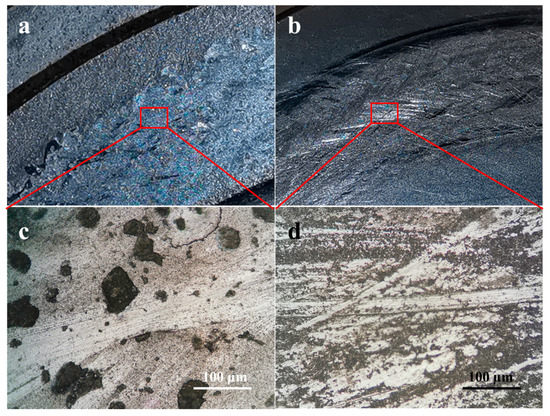
Figure 10.
Optical micrograph showing the surface microstructure of (a), (c) PCD coated ring and (b), (d) SSiC ring after PV testing.
The morphology of the PCD/graphite combination rings after PV testing can be seen in Figure 11. On the surface of the PCD coated ring (Figure 11a,c), the sliding tracks were not obvious, while an amount of adherent graphite was detected. This graphite probably resulted from abrasion and the transfer from the graphite mating face during the PV testing. Macroscopic scratches and breakages can be seen visibly on the surface of graphite ring (Figure 11b,d).
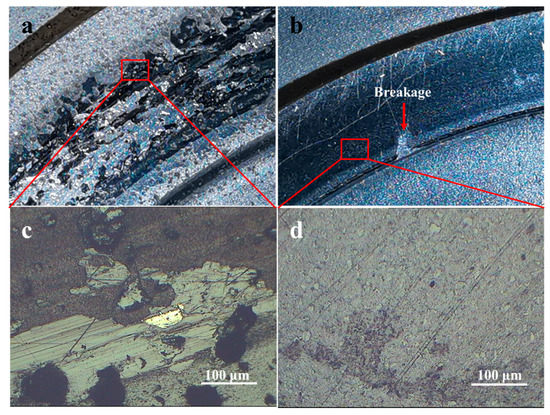
Figure 11.
Optical micrograph showing the surface microstructure of (a), (c) PCD coated ring and (b), (d) graphite ring after PV testing.
4. Conclusions
In order to enable mechanical seals to be applied to more severe conditions, PCD coated mechanical seal rings were prepared by HFCVD on GSiC substrates. The evolution of phase and morphologies on the substrate surface from the initial deposition process to the final state was investigated. PCD grows from crystal nucleus into a dense coating with grain size of 4 μm and thickness of 12.3 μm. The Raman spectrum and XRD results show the good crystallinity of finial PCD coating.
It is confirmed that a PCD coating significantly improves the PV limit of mechanical seals applied in harsh operating conditions, by comparing PV testing of PCD/SSiC combination, PCD/graphite combination, GSiC/SSiC combination and GSiC/graphite combination. The mechanical seal with the PCD/SSiC combination shows the highest PV limit of 42.31 MPa·m/s with 4 kN loading at 4500 rpm rotation speed. The frictional heat ΔT of all four combinations is as a function of increasing PV for the combinations examined while the friction coefficient of PCD/SSiC combination reduced to 0.003 with increasing PV value over 15 MPa·m/s. The extremely low and stable friction coefficient and super mechanical properties under harsh conditions can be approved as the source of the high PV limit of PCD coating. The PV limit in this study can provide an important guide to material performance and a mechanical seal with PCD coating can be used for more demanding applications.
Author Contributions
Conceptualization, N.J.; data curation, D.G. and N.C.; formal analysis, D.G. and N.C.; funding acquisition, D.G. and N.J.; investigation, D.G.; methodology, D.G., G.W., F.X. and S.T.; project administration, G.W., F.X. and N.J.; supervision, G.W., F.X. and H.L.; writing—original draft, D.G.; writing—review and editing, H.L. All authors have read and agreed to the published version of the manuscript.
Funding
This research was funded by Ningbo Marine Economy Innovation and Development Demonstration Project of State Oceanic Administration and Ministry of Finance, China, grant number NBHY-2017-Z3; and Advanced Postdoctoral Programs of Zhejiang Province, China, grant number zj20180045.
Conflicts of Interest
The authors declare no conflict of interest.
References
- Lai, T.W. Development of high pressure-velocity contacting plain face seals for sealing water. Tribol. Trans. 2020, 63, 477–486. [Google Scholar] [CrossRef]
- Shabani, M.; Carrapichano, J.M.; Oliveira, F.J.; Silva, R.F. Multilayered diamond mechanical seal rings under biodiesel lubrication and the fue all sealing conditions of pressurized water. Wear 2017, 384, 178–184. [Google Scholar] [CrossRef]
- Flitney, R. Chapter Five-Materials. In Seals and Sealing Handbook, 6th ed.; Flitney, R., Ed.; Butterworth-Heinemann: Oxford, UK, 2014; pp. 369–435. [Google Scholar]
- Tome, M.A.; Fernandes, A.J.S.; Oliveira, F.J.; Silva, R.F.; Carrapichano, J.M. High performance sealing with CVD diamond self-mated rings. Diam. Relat. Mater. 2005, 14, 617–621. [Google Scholar] [CrossRef]
- Kovalchenko, A.M.; Elam, J.W.; Erdemir, A.; Carlisle, J.A.; Auciello, O.; Libera, J.A.; Pellin, M.J.; Gruen, D.M.; Hryn, J.N. Development of ultrananocrystalline diamond (UNCD) coatings for multipurpose mechanical pump seals. Wear 2011, 270, 325–331. [Google Scholar] [CrossRef]
- Hollman, P.; Bjorkman, H.; Alahelisten, A.; Hogmark, S. Diamond coatings applied to mechanical face seals. Surf. Coat. Technol. 1998, 105, 169–174. [Google Scholar] [CrossRef]
- Kelly, P.J.; Arnell, R.D.; Hudson, M.D.; Wilson, A.E.J.; Jones, G. Enhanced mechanical seal performance through CVD diamond films. Vacuum 2001, 61, 61–74. [Google Scholar] [CrossRef]
- Jones, G.A. On the tribological behaviour of mechanical seal face materials in dry line contact-Part II. Bulk ceramics, diamond and diamond-like carbon films. Wear 2004, 256, 433–455. [Google Scholar] [CrossRef]
- Sumant, A.V.; Krauss, A.R.; Gruen, D.M.; Auciello, O.; Erdemir, A.; Williams, M.; Artiles, A.F.; Adams, W. Ultrananocrystalline diamond film as a wear-resistant and protective coating for mechanical seal applications. Tribol. Trans. 2005, 48, 24–31. [Google Scholar] [CrossRef]
- Jones, G.A.; Arnell, D.; Kelly, P. On the Potential of CVD diamond films as mechanical seal face materials. Tribol. Trans. 2008, 51, 33–43. [Google Scholar] [CrossRef]
- Mubarok, F.; Carrapichano, J.M.; Almeida, F.A.; Fernandes, A.J.S.; Silva, R.F. Enhanced sealing performance with CVD nanocrystalline diamond films in self-mated mechanical seals. Diam. Relat. Mater. 2008, 17, 1132–1136. [Google Scholar] [CrossRef]
- He, Y.; Sun, F.H.; Lei, X.L. Optimization of depositing uniform and wear-resistant diamond films on massive mechanical seals. Ind. Lubr. Tribol. 2018, 70, 97–104. [Google Scholar] [CrossRef]
- Shankar, S.; Krishnakumar, P. Frictional characteristics of PVD coated mechanical seals against carbon under various classes of liquid lubricants. Ind. Lubr. Tribol. 2016, 68, 597–602. [Google Scholar] [CrossRef]
- Nagasaka, H.; Ito, K.; Mori, J.; Shimizu, T.; Sasaki, S. Tribological properties of polycrystalline diamond films prepared by hot-filament chemical vapor deposition methods. In Proceedings of the 2016 IEEE 16th International Conference on Nanotechnology (IEEE-NANO), Sendai, Japan, 22–25 August 2016; IEEE: New York, NY, USA, 2016; pp. 616–619. [Google Scholar]
- Wheeler, D. Applications of diamond to improve tribological performance in the oil and gas industry. Lubricants 2018, 6, 84. [Google Scholar] [CrossRef]
- Simoes, R.; Martins, B.; Santos, J.; Neto, V. HFCVD diamond-coated mechanical seals. Coatings 2018, 8, 172. [Google Scholar] [CrossRef]
- Burton, J.C.; Sun, L.; Long, F.H.; Feng, Z.C.; Ferguson, I.T. First- and second-order Raman scattering from semi-insulating 4H-SiC. Phys. Rev. B 1999, 59, 7282–7284. [Google Scholar] [CrossRef]
- Kunert, H.W.; Maurice, T.; Barnas, J.; Malherbe, J.; Brink, D.J.; Prinsloo, L. Raman and photoluminescence spectroscopy from n- and p-type 6H-SIC alpha-particle irradiated. Vacuum 2005, 78, 503–508. [Google Scholar] [CrossRef]
- Prawer, S.; Nugent, K.W.; Jamieson, D.N.; Orwa, J.O.; Bursill, L.A.; Peng, J.L. The Raman spectrum of nanocrystalline diamond. Chem. Phys. Lett. 2000, 332, 93–97. [Google Scholar] [CrossRef]
- Liang, X.; Wang, L.; Zhu, H.; Yang, D. Effect of pressure on nanocrystalline diamond films deposition by hot filament CVD technique from CH4/H2 gas mixture. Surf. Coat. Technol. 2007, 202, 261–267. [Google Scholar] [CrossRef]
- Lin, T.; Yu, G.Y.; Wee, A.T.S.; Shen, Z.X.; Loh, K.P. Compositional mapping of the argon–methane–hydrogen system for polycrystalline to nanocrystalline diamond film growth in a hot-filament chemical vapor deposition system. Appl. Phys. Lett. 2000, 77, 2692–2694. [Google Scholar] [CrossRef]
- Kuzmany, H.; Pfeiffer, R.; Salk, N.; Günther, B. The mystery of the 1140 cm−1 Raman line in nanocrystalline diamond films. Carbon 2004, 42, 911–917. [Google Scholar] [CrossRef]
- Cebik, J.; McDonough, J.K.; Peerally, F.; Medrano, R.; Neitzel, I.; Gogotsi, Y.; Osswald, S. Raman spectroscopy study of the nanodiamond-to-carbon onion transformation. Nanotechnology 2013, 24, 205703. [Google Scholar] [CrossRef] [PubMed]
© 2020 by the authors. Licensee MDPI, Basel, Switzerland. This article is an open access article distributed under the terms and conditions of the Creative Commons Attribution (CC BY) license (http://creativecommons.org/licenses/by/4.0/).